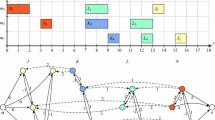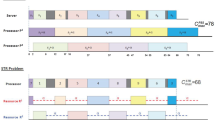Abstract
The job-shop problem is one of the most difficult NP-hard scheduling problems. A 10×10-problem published in 1963 has been solved only recently by Carlier and Pinson using a branch and bound method. Other branch and bound algorithms have been developed recently. The efficiency of all these branch and bound methods relies on the concept of immediate selection which allows to introduce order relations on the setI of all operations to be processed on the same machine before branching. We present new algorithms for immediate selection. Among them are
-
•
anO(max {n logn,f})-algorithm for fixing all disjunctions induced by cliques;
-
•
anO(n 2)-algorithm based on concepts which are different from those used by Carlier and Pinson.
Here,n is the number of operations inI andf is the number of induced order relations.
Similar content being viewed by others
References
J. Adams, E. Balas and D. Zawack, The shifting bottleneck procedure for job-shop scheduling, Manag. Sci. 34(1988)391–401.
D. Applegate and W. Cook, A computational study of the job shop scheduling problem, ORSA J. Comp. 3(1991)149–156.
P. Brucker, B. Jurisch and B. Sievers, A branch and bound algorithm for the job-shop scheduling problem(1991), to appear in Discr. Appl. Math.
J. Carlier, One machine sequencing problem, Eur. J. Oper. Res. 11(1982)42–47.
J. Carlier and E. Pinson, An algorithm for solving the job-shop problem, Manag. Sci. 35(1989)164–176.
J. Carlier and E. Pinson, A practical use of Jackson's preemptive schedule for solving the job shop problem, Ann. Oper. Res. 26(1990)269–287.
G. Deweß, An existence theorem for packing problems with implications for the computation of optimal machine schedules, Optimization 25(1992)261–269.
M.J. Fischer and A.R. Meyer, Boolean matrix multiplication and transitive closure,12th Annual Symp. on Switching and Automata Theory, East Lansing, MI (1971) pp. 129–137.
J.F. Muth and G.L. Thompson,Industrial Scheduling (Prentice Hall, Englewood Cliffs, NJ, 1963).
B. Roy and B. Sussmann, Les Problèmes d'ordonnancement avec contraintes disjonctives, Note DS no. 9 bis, SEMA, Paris (1964).
Author information
Authors and Affiliations
Additional information
Supported by the Deutsche Forschungsgemeinschaft, Project JoPTAG.
Rights and permissions
About this article
Cite this article
Brucker, P., Jurisch, B. & Krämer, A. The job-shop problem and immediate selection. Ann Oper Res 50, 73–114 (1994). https://doi.org/10.1007/BF02085636
Issue Date:
DOI: https://doi.org/10.1007/BF02085636




